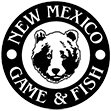New Mexico Department of Game and Fish
Contact: Dan Williams, (505) 476-8004
dan.williams@state.nm.us
New Mexico Department of Transportation
Contact: Megan Arredondo
megan.arredondo@state.nm.us
FOR IMMEDIATE RELEASE, SEPT. 14, 2007:
ELECTRIC FENCING, HIGHWAY MATS GIVE WILDLIFE SAFER PASSAGE IN TIJERAS CANYON
TIJERAS -- Deer and other wildlife now can commute more safely between habitats in the Sandia and Manzano mountains east of Albuquerque with the activation of electric fencing and highway mats designed to provide the animals safe passage over and below Interstate 40 and N.M. 333, formerly Route 66.
Turning on the power was among the final steps in the development of a $750,000 system to reduce wildlife-vehicle collisions along five miles through Tijeras Canyon . Representatives of the New Mexico Department of Game and Fish, Department of Transportation, the Tijeras Canyon Safe Passage Coalition, and the Wild Friends group gathered Tuesday for the ceremonial "flip of the switch." The electrical system is a vital component of the project, which also includes 8-foot wildlife-proof fencing, passages under existing overpasses, warning signs and solar-powered motion-detecting cameras that turn on highway caution lights.
"This is the only system of its kind in New Mexico and among only a few in the United States ," said Mark Watson, a habitat specialist with the Department of Game and Fish. "We're expecting it to significantly reduce vehicle-wildlife collisions in Tijeras Canyon and reconnect Sandia and Manzano mountain wildlife habitats."
The project has roots in the 2003 Legislature and House Joint Memorial 3, sponsored by Rep. Mimi Stewart and supported by the conservation group Wild Friends . The memorial directed the Department of Game and Fish and the Department of Transportation to work together to reduce wildlife-vehicle collisions in New Mexico .
"Safety was a key issue when tackling this project," said Transportation Secretary Rhonda Faught. "This particular wildlife crossing was identified among the four highest risks areas in the state where large game animals and vehicles collide. With the additions to the new corridor, we are creating a safe passage for wildlife and safe travel for people."
The 7-foot-high Electrobraid fencing is designed to deliver a mild shock to animals that touch it, discouraging them from passing through. The fences consist of several horizontal strands of black rope-like material that is about a half-inch in diameter. The fence can deliver a 6,000- to 7,000-volt, 4 milliamp shock for 3/10,000th of a second -- enough to sting, but not seriously harm a human. The fence will be monitored by satellite 24 hours a day by the Electrobraid Fence Company in New Brunswick, Canada.
The project also includes seven Electro-mats, which are built into roadways and act like electrical cattle guards, preventing wildlife or other animals from crossing. The approximately 4-foot-wide mats span the roadways in five locations along N.M. 333 and across the I-40 on- and off-ramps at Tijeras. The mats along N.M. 333 are designed to encourage wildlife to cross the road in designated areas where motion-detecting cameras and caution lights will alert motorists to slow down when wildlife are present. The on- and off-ramp mats are designed to keep wildlife off the freeway. Twelve specially designed escape ramps were constructed in case animals somehow become trapped inside the fencing along I-40.
Pedestrians wearing shoes will be able to safely walk across the Electro-mats. Bicyclists also can safely cross the mats. However, the mats will deliver shocks to dogs, horses or people without shoes.
The additions to the wildlife corridor were included in the $27 million GRIP I-40 Carnuel-to-Tijeras project. Governor Richardson's Investment Partnership, or GRIP, is a $1.6 billion transportation initiative aimed at improving the state's highways, while creating thousands of local jobs.
The Department of Game and Fish will monitor Phase I of the system to evaluate its effectiveness in reducing vehicle-wildlife collisions and directing wildlife to safe passages across and under the highways. Should it prove to be ineffective, the Department of Transportation's Phase II and Phase III strategies call for more passages, possibly including a land bridge over I-40.
###

